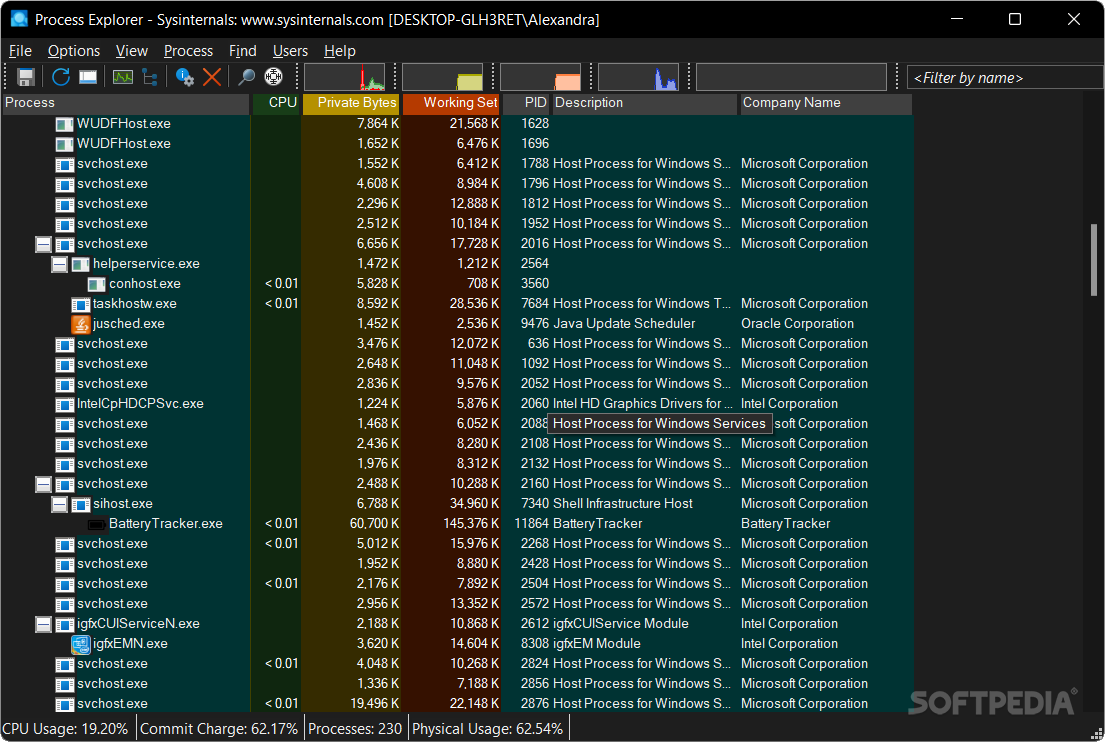

- How to run process explorer for free#
- How to run process explorer software#
- How to run process explorer series#
- How to run process explorer windows#
Every process starts with one thread (runs “main” program).Security token (can be analyzed with PE/PM)Įxecution context within a process.Open handles (can be analyzed with PE/PM).Address space – shared among threads (see below).
How to run process explorer windows#
Some definitionsĪs Windows expert David Solomon points out,what is actually running on your system are not processes, but threads inside these processes: Does the program spawn another executable which is not whitelisted in my firewall rules or SRPs? Does it try to access a folder which I did not grant permissions for? Which program is making my system so slow? A brief look into Process Explorer and Process Manager can answer such and many more questions.
How to run process explorer software#
They are also very helpful for tuning firewall rules and software restriction policies (SRP), because if some process lacks required permissions, you can see immediately where adjustments are needed. In fact, I do not only use these tools to identify potential malware. I will write another post on best practices for Process Monitor. In this blog post I just want to explain some useful tricks and features that I use most often when working with Process Explorer.
How to run process explorer series#
You should however always keep in mind that you might be dealing with some kind of virus or malware that hides from Process Explorer and Process Monitor or that circumvents detection by manipulating the system on kernel level.īy the way, if you are interested in a real-world example, I can recommend Mark Russinovich’s (slightly dated) series ( part 1, part 2, part 3) on analyzing Stuxnet with Sysinternals.

Especially in situations where clients got a SIEM alert that a workstation communicated with a malicious website but then cannot find anything suspicious on the system itself, I recommend to run Process Explorer and Process Monitor to find out more about the threads running on the system and to see which program is responsible for the potentially malicious connection attempts. Process Monitor on the other hand is something what I would call “ SIEM for processes” because it shows in realtime all system activity (files, registry, network, processes and threads) and allows to filter and search for “threats in the threads”. Mark Russinovich calls Process Explorer a “Super Task Manager” because of it’s great functionality to analyze processes and threads. Also for system scanning, there are many other tools, for example LOKI IoC Scanner, but for a quick start and a straightforward user experience, Process Explorer and Process Monitor are a good choice to get a quick understanding of what certain software is doing on your system. For hardcode forensics you would probably want to use other tools. Process Explorer and Process Monitor are two software solutions from the Sysinternals bundle which allow to look very deeply into what is happening in your Windows system. Apparently someone with a strong technical background in this C-level position. Moreover, it comes from a trusted source (Microsoft) and does not require too much training.įun fact: The original developer of Sysinternals – Mark Russinovich – is now CTO for Microsoft Azure. Really all of the included tools (of the many I tried so far) are very helpful for specific purposes and it does not come as a surprise that Microsoft bought the previously independent company “Winternals” years ago.įor my work as Security Consultant I also like to recommend these tools to my clients because the software is self-contained, i.e.
How to run process explorer for free#
In CygWin you will need them to be able to view an administrator's process (what seems more logical to me: the full command-line could have some parameters like passwords inside), so we must run the CygWin Bash in elevated Administrator Mode.ĮDIT-1: This problem will not happen if you run Process Explorer as administrator.The Sysinternals suite is a toolkit that can be downloaded for free from the Microsoft website. It is useful to know this, as long as CygWin cohabits with no problems in Windows, and you can use it to run many POSIX and Python programs.ĮDIT: In Windows you don't seem to need administrator priviledges for tasklist. So, the only trick I know until now, is finding it via CygWin Bash shell pgrep: /cygdrive/c/ĥ740 /usr/bin/python2.7 /usr/local/bin/sudoserver.py Same results for tasklist: C:\>tasklist | find "python" /i When using CygWin, if I start a Python process, this is an example of command line: c:\CygWin\bin\python2.7.exe /usr/local/bin/sudoserver.pyīut Process Explorer only sees the main exe:


 0 kommentar(er)
0 kommentar(er)
